Upper Rhine Railway Company
| Upper Rhine Railway Company | |||||||||||||||||||||||||||||||||||||||||||||||||||||||||||||||||||||||||||||||||||||||||||||||||||||||||||||||||||||||||||||||||||||||||||||||||||||||||||||||||||||||||||||||||||||||||||||||||||||||||||||||||||||||||||||||||||||||||||||||||||||||||||||||||||||||||||||||||||||||||||||||||||||||||||||||||||||||||||||||||||||||||||||||||||||||||||||||||||||||||||||||||||||||||||||||||||||||||||||||||||||||||||||||||||||||||||||||||||||||||||||||||||||||||||||||||||||||||||||||||||||||||||||||||||||||||||||||||||||||||||||||||||||||||||||||||||||||||||||||||||||||||||||||||||||||||||||||||||||||||||||||||||||||||||||||||||||||||||||||||||||||||||||||||||||||||||||||||||||||||||||||||||||||||||||||||||||||||||||||||||||||||||||||||||||||||||||||||||||||||||||||||||||||||||||||||||||||||||||||||||||||||||||||||||||||||||||||||||||||||||||||||||||||||||||||||||||||||||||||||||||||||||||||||||||||||||||||||||||||||||||||||||||||||||||||||||||||
|---|---|---|---|---|---|---|---|---|---|---|---|---|---|---|---|---|---|---|---|---|---|---|---|---|---|---|---|---|---|---|---|---|---|---|---|---|---|---|---|---|---|---|---|---|---|---|---|---|---|---|---|---|---|---|---|---|---|---|---|---|---|---|---|---|---|---|---|---|---|---|---|---|---|---|---|---|---|---|---|---|---|---|---|---|---|---|---|---|---|---|---|---|---|---|---|---|---|---|---|---|---|---|---|---|---|---|---|---|---|---|---|---|---|---|---|---|---|---|---|---|---|---|---|---|---|---|---|---|---|---|---|---|---|---|---|---|---|---|---|---|---|---|---|---|---|---|---|---|---|---|---|---|---|---|---|---|---|---|---|---|---|---|---|---|---|---|---|---|---|---|---|---|---|---|---|---|---|---|---|---|---|---|---|---|---|---|---|---|---|---|---|---|---|---|---|---|---|---|---|---|---|---|---|---|---|---|---|---|---|---|---|---|---|---|---|---|---|---|---|---|---|---|---|---|---|---|---|---|---|---|---|---|---|---|---|---|---|---|---|---|---|---|---|---|---|---|---|---|---|---|---|---|---|---|---|---|---|---|---|---|---|---|---|---|---|---|---|---|---|---|---|---|---|---|---|---|---|---|---|---|---|---|---|---|---|---|---|---|---|---|---|---|---|---|---|---|---|---|---|---|---|---|---|---|---|---|---|---|---|---|---|---|---|---|---|---|---|---|---|---|---|---|---|---|---|---|---|---|---|---|---|---|---|---|---|---|---|---|---|---|---|---|---|---|---|---|---|---|---|---|---|---|---|---|---|---|---|---|---|---|---|---|---|---|---|---|---|---|---|---|---|---|---|---|---|---|---|---|---|---|---|---|---|---|---|---|---|---|---|---|---|---|---|---|---|---|---|---|---|---|---|---|---|---|---|---|---|---|---|---|---|---|---|---|---|---|---|---|---|---|---|---|---|---|---|---|---|---|---|---|---|---|---|---|---|---|---|---|---|---|---|---|---|---|---|---|---|---|---|---|---|---|---|---|---|---|---|---|---|---|---|---|---|---|---|---|---|---|---|---|---|---|---|---|---|---|---|---|---|---|---|---|---|---|---|---|---|---|---|---|---|---|---|---|---|---|---|---|---|---|---|---|---|---|---|---|---|---|---|---|---|---|---|---|---|---|---|---|---|---|---|---|---|---|---|---|---|---|---|---|---|---|---|---|---|---|---|---|---|---|---|---|---|---|---|---|---|---|---|---|---|---|---|---|---|---|---|---|---|---|---|---|---|---|---|---|---|---|---|---|---|---|---|---|---|---|---|---|---|---|---|---|---|---|---|---|---|---|---|---|---|---|---|---|---|---|---|---|---|---|---|---|---|---|---|---|---|---|---|---|---|---|---|---|---|---|---|---|---|---|---|---|---|---|---|---|---|---|---|---|---|---|---|---|---|---|---|---|---|---|---|---|---|---|---|---|---|---|---|---|---|---|---|---|---|---|---|---|---|---|---|---|---|---|---|---|---|---|---|---|---|---|---|---|---|---|---|---|---|---|---|---|---|---|---|---|---|---|---|---|---|---|---|---|---|---|---|---|---|---|---|---|---|---|---|---|---|---|---|---|---|---|---|---|---|---|---|---|---|---|---|---|---|---|---|---|---|---|---|---|---|---|---|---|---|---|---|---|---|---|---|---|---|---|---|---|---|---|---|---|---|---|---|---|---|---|---|---|---|---|---|---|---|---|---|---|---|---|---|---|---|---|---|---|---|---|---|---|---|---|---|---|---|---|---|---|---|---|---|---|---|---|---|---|---|---|---|---|---|---|---|---|---|---|---|---|---|---|---|---|---|---|---|---|---|---|---|---|---|---|---|---|---|---|---|---|---|---|---|---|---|---|---|---|---|---|---|---|---|---|---|---|---|---|---|---|---|---|---|---|---|---|---|---|---|---|---|---|---|---|---|---|---|---|---|---|---|---|---|---|---|---|---|---|---|---|---|---|---|---|---|---|---|---|---|---|---|---|---|---|---|---|---|---|---|---|---|---|---|---|---|---|---|---|---|---|---|---|---|---|---|---|---|---|---|---|---|---|---|---|---|---|---|---|---|---|---|---|---|---|---|---|---|---|---|---|---|---|---|---|---|---|---|---|---|---|---|---|---|---|---|
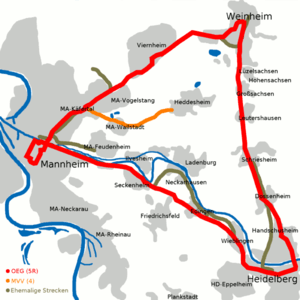 | |||||||||||||||||||||||||||||||||||||||||||||||||||||||||||||||||||||||||||||||||||||||||||||||||||||||||||||||||||||||||||||||||||||||||||||||||||||||||||||||||||||||||||||||||||||||||||||||||||||||||||||||||||||||||||||||||||||||||||||||||||||||||||||||||||||||||||||||||||||||||||||||||||||||||||||||||||||||||||||||||||||||||||||||||||||||||||||||||||||||||||||||||||||||||||||||||||||||||||||||||||||||||||||||||||||||||||||||||||||||||||||||||||||||||||||||||||||||||||||||||||||||||||||||||||||||||||||||||||||||||||||||||||||||||||||||||||||||||||||||||||||||||||||||||||||||||||||||||||||||||||||||||||||||||||||||||||||||||||||||||||||||||||||||||||||||||||||||||||||||||||||||||||||||||||||||||||||||||||||||||||||||||||||||||||||||||||||||||||||||||||||||||||||||||||||||||||||||||||||||||||||||||||||||||||||||||||||||||||||||||||||||||||||||||||||||||||||||||||||||||||||||||||||||||||||||||||||||||||||||||||||||||||||||||||||||||||||||
| Overview | |||||||||||||||||||||||||||||||||||||||||||||||||||||||||||||||||||||||||||||||||||||||||||||||||||||||||||||||||||||||||||||||||||||||||||||||||||||||||||||||||||||||||||||||||||||||||||||||||||||||||||||||||||||||||||||||||||||||||||||||||||||||||||||||||||||||||||||||||||||||||||||||||||||||||||||||||||||||||||||||||||||||||||||||||||||||||||||||||||||||||||||||||||||||||||||||||||||||||||||||||||||||||||||||||||||||||||||||||||||||||||||||||||||||||||||||||||||||||||||||||||||||||||||||||||||||||||||||||||||||||||||||||||||||||||||||||||||||||||||||||||||||||||||||||||||||||||||||||||||||||||||||||||||||||||||||||||||||||||||||||||||||||||||||||||||||||||||||||||||||||||||||||||||||||||||||||||||||||||||||||||||||||||||||||||||||||||||||||||||||||||||||||||||||||||||||||||||||||||||||||||||||||||||||||||||||||||||||||||||||||||||||||||||||||||||||||||||||||||||||||||||||||||||||||||||||||||||||||||||||||||||||||||||||||||||||||||||||
| Native name | Oberrheinische Eisenbahn | ||||||||||||||||||||||||||||||||||||||||||||||||||||||||||||||||||||||||||||||||||||||||||||||||||||||||||||||||||||||||||||||||||||||||||||||||||||||||||||||||||||||||||||||||||||||||||||||||||||||||||||||||||||||||||||||||||||||||||||||||||||||||||||||||||||||||||||||||||||||||||||||||||||||||||||||||||||||||||||||||||||||||||||||||||||||||||||||||||||||||||||||||||||||||||||||||||||||||||||||||||||||||||||||||||||||||||||||||||||||||||||||||||||||||||||||||||||||||||||||||||||||||||||||||||||||||||||||||||||||||||||||||||||||||||||||||||||||||||||||||||||||||||||||||||||||||||||||||||||||||||||||||||||||||||||||||||||||||||||||||||||||||||||||||||||||||||||||||||||||||||||||||||||||||||||||||||||||||||||||||||||||||||||||||||||||||||||||||||||||||||||||||||||||||||||||||||||||||||||||||||||||||||||||||||||||||||||||||||||||||||||||||||||||||||||||||||||||||||||||||||||||||||||||||||||||||||||||||||||||||||||||||||||||||||||||||||||||
| Locale | Baden-Württemberg | ||||||||||||||||||||||||||||||||||||||||||||||||||||||||||||||||||||||||||||||||||||||||||||||||||||||||||||||||||||||||||||||||||||||||||||||||||||||||||||||||||||||||||||||||||||||||||||||||||||||||||||||||||||||||||||||||||||||||||||||||||||||||||||||||||||||||||||||||||||||||||||||||||||||||||||||||||||||||||||||||||||||||||||||||||||||||||||||||||||||||||||||||||||||||||||||||||||||||||||||||||||||||||||||||||||||||||||||||||||||||||||||||||||||||||||||||||||||||||||||||||||||||||||||||||||||||||||||||||||||||||||||||||||||||||||||||||||||||||||||||||||||||||||||||||||||||||||||||||||||||||||||||||||||||||||||||||||||||||||||||||||||||||||||||||||||||||||||||||||||||||||||||||||||||||||||||||||||||||||||||||||||||||||||||||||||||||||||||||||||||||||||||||||||||||||||||||||||||||||||||||||||||||||||||||||||||||||||||||||||||||||||||||||||||||||||||||||||||||||||||||||||||||||||||||||||||||||||||||||||||||||||||||||||||||||||||||||||
| Line number |
| ||||||||||||||||||||||||||||||||||||||||||||||||||||||||||||||||||||||||||||||||||||||||||||||||||||||||||||||||||||||||||||||||||||||||||||||||||||||||||||||||||||||||||||||||||||||||||||||||||||||||||||||||||||||||||||||||||||||||||||||||||||||||||||||||||||||||||||||||||||||||||||||||||||||||||||||||||||||||||||||||||||||||||||||||||||||||||||||||||||||||||||||||||||||||||||||||||||||||||||||||||||||||||||||||||||||||||||||||||||||||||||||||||||||||||||||||||||||||||||||||||||||||||||||||||||||||||||||||||||||||||||||||||||||||||||||||||||||||||||||||||||||||||||||||||||||||||||||||||||||||||||||||||||||||||||||||||||||||||||||||||||||||||||||||||||||||||||||||||||||||||||||||||||||||||||||||||||||||||||||||||||||||||||||||||||||||||||||||||||||||||||||||||||||||||||||||||||||||||||||||||||||||||||||||||||||||||||||||||||||||||||||||||||||||||||||||||||||||||||||||||||||||||||||||||||||||||||||||||||||||||||||||||||||||||||||||||||||
| Technical | |||||||||||||||||||||||||||||||||||||||||||||||||||||||||||||||||||||||||||||||||||||||||||||||||||||||||||||||||||||||||||||||||||||||||||||||||||||||||||||||||||||||||||||||||||||||||||||||||||||||||||||||||||||||||||||||||||||||||||||||||||||||||||||||||||||||||||||||||||||||||||||||||||||||||||||||||||||||||||||||||||||||||||||||||||||||||||||||||||||||||||||||||||||||||||||||||||||||||||||||||||||||||||||||||||||||||||||||||||||||||||||||||||||||||||||||||||||||||||||||||||||||||||||||||||||||||||||||||||||||||||||||||||||||||||||||||||||||||||||||||||||||||||||||||||||||||||||||||||||||||||||||||||||||||||||||||||||||||||||||||||||||||||||||||||||||||||||||||||||||||||||||||||||||||||||||||||||||||||||||||||||||||||||||||||||||||||||||||||||||||||||||||||||||||||||||||||||||||||||||||||||||||||||||||||||||||||||||||||||||||||||||||||||||||||||||||||||||||||||||||||||||||||||||||||||||||||||||||||||||||||||||||||||||||||||||||||||||
| Track gauge | 1,000 mm (3 ft 3 3⁄8 in) metre gauge | ||||||||||||||||||||||||||||||||||||||||||||||||||||||||||||||||||||||||||||||||||||||||||||||||||||||||||||||||||||||||||||||||||||||||||||||||||||||||||||||||||||||||||||||||||||||||||||||||||||||||||||||||||||||||||||||||||||||||||||||||||||||||||||||||||||||||||||||||||||||||||||||||||||||||||||||||||||||||||||||||||||||||||||||||||||||||||||||||||||||||||||||||||||||||||||||||||||||||||||||||||||||||||||||||||||||||||||||||||||||||||||||||||||||||||||||||||||||||||||||||||||||||||||||||||||||||||||||||||||||||||||||||||||||||||||||||||||||||||||||||||||||||||||||||||||||||||||||||||||||||||||||||||||||||||||||||||||||||||||||||||||||||||||||||||||||||||||||||||||||||||||||||||||||||||||||||||||||||||||||||||||||||||||||||||||||||||||||||||||||||||||||||||||||||||||||||||||||||||||||||||||||||||||||||||||||||||||||||||||||||||||||||||||||||||||||||||||||||||||||||||||||||||||||||||||||||||||||||||||||||||||||||||||||||||||||||||||||
| Minimum radius | 23 m (75 ft) | ||||||||||||||||||||||||||||||||||||||||||||||||||||||||||||||||||||||||||||||||||||||||||||||||||||||||||||||||||||||||||||||||||||||||||||||||||||||||||||||||||||||||||||||||||||||||||||||||||||||||||||||||||||||||||||||||||||||||||||||||||||||||||||||||||||||||||||||||||||||||||||||||||||||||||||||||||||||||||||||||||||||||||||||||||||||||||||||||||||||||||||||||||||||||||||||||||||||||||||||||||||||||||||||||||||||||||||||||||||||||||||||||||||||||||||||||||||||||||||||||||||||||||||||||||||||||||||||||||||||||||||||||||||||||||||||||||||||||||||||||||||||||||||||||||||||||||||||||||||||||||||||||||||||||||||||||||||||||||||||||||||||||||||||||||||||||||||||||||||||||||||||||||||||||||||||||||||||||||||||||||||||||||||||||||||||||||||||||||||||||||||||||||||||||||||||||||||||||||||||||||||||||||||||||||||||||||||||||||||||||||||||||||||||||||||||||||||||||||||||||||||||||||||||||||||||||||||||||||||||||||||||||||||||||||||||||||||||
| Electrification | 750 V DC Overhead catenary | ||||||||||||||||||||||||||||||||||||||||||||||||||||||||||||||||||||||||||||||||||||||||||||||||||||||||||||||||||||||||||||||||||||||||||||||||||||||||||||||||||||||||||||||||||||||||||||||||||||||||||||||||||||||||||||||||||||||||||||||||||||||||||||||||||||||||||||||||||||||||||||||||||||||||||||||||||||||||||||||||||||||||||||||||||||||||||||||||||||||||||||||||||||||||||||||||||||||||||||||||||||||||||||||||||||||||||||||||||||||||||||||||||||||||||||||||||||||||||||||||||||||||||||||||||||||||||||||||||||||||||||||||||||||||||||||||||||||||||||||||||||||||||||||||||||||||||||||||||||||||||||||||||||||||||||||||||||||||||||||||||||||||||||||||||||||||||||||||||||||||||||||||||||||||||||||||||||||||||||||||||||||||||||||||||||||||||||||||||||||||||||||||||||||||||||||||||||||||||||||||||||||||||||||||||||||||||||||||||||||||||||||||||||||||||||||||||||||||||||||||||||||||||||||||||||||||||||||||||||||||||||||||||||||||||||||||||||||
| Operating speed | 80 km/h (50 mph) (maximum) | ||||||||||||||||||||||||||||||||||||||||||||||||||||||||||||||||||||||||||||||||||||||||||||||||||||||||||||||||||||||||||||||||||||||||||||||||||||||||||||||||||||||||||||||||||||||||||||||||||||||||||||||||||||||||||||||||||||||||||||||||||||||||||||||||||||||||||||||||||||||||||||||||||||||||||||||||||||||||||||||||||||||||||||||||||||||||||||||||||||||||||||||||||||||||||||||||||||||||||||||||||||||||||||||||||||||||||||||||||||||||||||||||||||||||||||||||||||||||||||||||||||||||||||||||||||||||||||||||||||||||||||||||||||||||||||||||||||||||||||||||||||||||||||||||||||||||||||||||||||||||||||||||||||||||||||||||||||||||||||||||||||||||||||||||||||||||||||||||||||||||||||||||||||||||||||||||||||||||||||||||||||||||||||||||||||||||||||||||||||||||||||||||||||||||||||||||||||||||||||||||||||||||||||||||||||||||||||||||||||||||||||||||||||||||||||||||||||||||||||||||||||||||||||||||||||||||||||||||||||||||||||||||||||||||||||||||||||||
| Route number | 669 (until 1970: 300g; until 1992: 568) | ||||||||||||||||||||||||||||||||||||||||||||||||||||||||||||||||||||||||||||||||||||||||||||||||||||||||||||||||||||||||||||||||||||||||||||||||||||||||||||||||||||||||||||||||||||||||||||||||||||||||||||||||||||||||||||||||||||||||||||||||||||||||||||||||||||||||||||||||||||||||||||||||||||||||||||||||||||||||||||||||||||||||||||||||||||||||||||||||||||||||||||||||||||||||||||||||||||||||||||||||||||||||||||||||||||||||||||||||||||||||||||||||||||||||||||||||||||||||||||||||||||||||||||||||||||||||||||||||||||||||||||||||||||||||||||||||||||||||||||||||||||||||||||||||||||||||||||||||||||||||||||||||||||||||||||||||||||||||||||||||||||||||||||||||||||||||||||||||||||||||||||||||||||||||||||||||||||||||||||||||||||||||||||||||||||||||||||||||||||||||||||||||||||||||||||||||||||||||||||||||||||||||||||||||||||||||||||||||||||||||||||||||||||||||||||||||||||||||||||||||||||||||||||||||||||||||||||||||||||||||||||||||||||||||||||||||||||||
| |||||||||||||||||||||||||||||||||||||||||||||||||||||||||||||||||||||||||||||||||||||||||||||||||||||||||||||||||||||||||||||||||||||||||||||||||||||||||||||||||||||||||||||||||||||||||||||||||||||||||||||||||||||||||||||||||||||||||||||||||||||||||||||||||||||||||||||||||||||||||||||||||||||||||||||||||||||||||||||||||||||||||||||||||||||||||||||||||||||||||||||||||||||||||||||||||||||||||||||||||||||||||||||||||||||||||||||||||||||||||||||||||||||||||||||||||||||||||||||||||||||||||||||||||||||||||||||||||||||||||||||||||||||||||||||||||||||||||||||||||||||||||||||||||||||||||||||||||||||||||||||||||||||||||||||||||||||||||||||||||||||||||||||||||||||||||||||||||||||||||||||||||||||||||||||||||||||||||||||||||||||||||||||||||||||||||||||||||||||||||||||||||||||||||||||||||||||||||||||||||||||||||||||||||||||||||||||||||||||||||||||||||||||||||||||||||||||||||||||||||||||||||||||||||||||||||||||||||||||||||||||||||||||||||||||||||||||||
The Upper Rhine Railway Company (German: Oberrheinische Eisenbahn, OEG), formerly the Oberrheinische Eisenbahn-Gesellschaft AG (Upper Rhine Railway Company Ltd), later MVV OEG AG, later operated by MVV Verkehr AG (the operator of the Mannheim Tramway) and now part of Rhein-Neckar-Verkehr (Rhine-Neckar Transport), is a metre gauge railway between the three cities of Mannheim, Heidelberg and Weinheim. A small section of standard gauge line between Heidelberg and Schriesheim was used only for moving freight. It is known by the acronym of OEG of the original operating company. It is listed in the timetable of Deutsche Bahn as route 669 and forms part of the network that is administered by the Verkehrsverbund Rhein-Neckar (Rhine-Neckar Transport Association, VRN).
The OEG is a non-federally own railway, which was built under the German ESBO narrow gauge railway regulations and operates in Mannheim and Heidelberg as a tram. It operates partly on the tracks of the MVV Verkehr AG and the Heidelberger Straßen- und Bergbahn AG (the Heidelberg Tramway, HSB). Because the OEG uses trams, it is perceived as a tramway rather than as an Interurban. Until December 2009, the OEG also operated the city buses in Weinheim, some bus routes in the southeast of Mannheim and several other bus routes in the vicinity of Schriesheim and Ladenburg.
History
Although Mannheim and Heidelberg were connected by the Rhine Valley Railway in 1840 and Weinheim was also connected by the Main-Neckar Railway in 1846, there were aspirations in the 1880s to build a narrow gauge railway to connect these three cities and the smaller places along the Neckar river and the Mountain Road. Specifically, the operator of the quarries in Schriesheim and Dossenheim wanted better facilities for the transport of freight as the Main-Neckar Railway bypassed the Mountain Road at this point.
In 1883, a company operating in the region as Gebrüder Leferenz (Leferenz Brothers) were granted the concession for a line from Heidelberg to Schriesheim, with a continuation to Weinheim. This could not be realised at that time for financial reasons.
The first years of operation
In 1886, the Centralverwaltung für Secundärbahnen Herrmann Bachstein (Hermann Bachstein Branch Line Central Organisation) was awarded the concession for the line from Mannheim to Käfertal and Viernheim to Weinheim, which was opened as soon as 1887. The consortium acquired the concession of the Leferenz Brothers and opened the line from Weinheim along the Mountain Road via Lützelsachsen, Hohensachsen, Großsachsen, Leutershausen, Schriesheim, Dossenheim and Handschuhsheim to Heidelberg in 1890.
In 1891, the line was continued first from Heidelberg to Edingen and a few weeks later the remaining line was opened via Neckarhausen and Seckenheim to Mannheim.
Finally in 1892, the gap was closed between the two stations in Mannheim (the Weinheim station north of the Neckar and the Heidelberg station south of the Neckar). These were connected over the Friedrich Bridge (now the Kurpfalz Bridge), but the link was only used for internal operations.
Takeover by the SEG
The Bachstein company was absorbed into the South German Railway Company (Süddeutsche Eisenbahn-Gesellschaft AG, SEG), founded in 1895, which took over the operations of the Mannheim-Weinheim-Heidelberg-Mannheimer Eisenbahn (MWHME) in 1897.
In 1903, the line from Mannheim towards Käfertal and Käfertaler Straße and Mannheimer Straße on the former Kronprinzenstraße (now Friedrich-Ebert-Straße) was moved and the SEG has since run together with the urban trams to and from Käfertal. A section of the old line in Mannheimer Straße remained as a connecting track to the national railway (at Käfertal station on the eastern branch of the Ried Railway) until 1971.
To enable a direct connection to the Dossenheimer and Schriesheimer quarries, in 1906, a freight-only railway line was opened from Heidelberg SEG freight yard over its own bridge over the Neckar through the Neuenheimer Feld to Dossenheim and further on to Schriesheim, allowing freight trains to avoid running through central Heidelberg. This line was built as a dual gauge track, allowing metre gauge and standard gauge freight trains to run, with some stations and company sidings built only with standard gauge track.
The final extension of the line followed on 1 May 1909 with the connection from Käfertal via Wallstadt to Heddesheim. This was unpopular with the citizens of Wallstadt but had a cheaper fare and more frequent service and better connections to the city of Mannheim than the Mannheim tram that ended in nearby Feudenheim, so many people walked from Freudenheim to Wallstadt.
For many decades a branch line, which was opened in 1888, ran from Käfertal Wald station to Käfertaler waterworks. This siding was used to supply the water plant with coal, which was necessary for the operation of the steam-driven pumps.
The OEG era
After the death of Hermann Bachstein in 1908, the Rhenish industrialist Hugo Stinnes took over the majority of SEG in1909 with the aim of taking control of the electric tramways of the Ruhr and other major cities as part of the RWE (Rheinisch-Westfälisches Elektrizitätswerk AG) power company so that they could be connected to the electric grid of western Germany. In order to focus on electric trams, a few railways were spun off the SEG and transferred to newly established companies.
In order to carry out the electrification of the line and to allow the expansion of its tram network, the city of Mannheim in cooperation with the SEG, which had acquired the Mannheim-Weinheim-Heidelberg-Mannheim railway, founded the Oberrheinische Eisenbahn-Gesellschaft AG (OEG) in 1911. In order to prevent domination by the RWE, the city of Mannheim held a majority of the shares of the company.[2] The Schwetzingen–Ketsch Tramway (Straßenbahn Schwetzingen–Ketsch) and two power plants in Ladenburg and Rheinau were acquired by the OEG. 51% of the share capital was held by the city of Mannheim and 26% by the SEG. The rest was accounted for by three other shareholders.
A target in the early days was an extension of the Mannheim–Weinheim line via Birkenau and Fürth to Reichelsheim with access to the SEG-owned Reinheim-Reichelsheim railway; this could not in the end be realised (the Weschnitz Valley Railway—Weschnitztalbahn—between Weinheim and Fürth is standard gauge). Nevertheless, in 1912, the line was relocated in Weinheim, including the construction of the OEG bridge over the Main-Neckar Railway. The old line ran from Stahlbad directly to the east—following the course of today's Breslauer Straße—to the freight yard, which was crossed by a bridge, then along the Mountain Road north to the Pfälzer Hof inn (at the site of the current town hall). The line built for the new OEG bridge was relocated to the route of today's Stahlbadstraße and Mannheimer Straße and the branch line from Bahnhofstraße to Pfälzer Hof was dismantled.
In 1913, the OEG tram route was opened from Neckarau to Rheinau (then called Rhenaniastraße). During the construction of the line, Rheinau was not yet incorporated in Mannheim, which according to existing cooperation agreements was in the jurisdiction of the OEG. With its incorporation in 1913 this changed, so the line was then run by the city's tramway and passed into its possession in 1921.
In 1914, the first section of the Mannheim–Feudenheim–Ilvesheim–Ladenburg–Schriesheim line was opened to Feudenheim for temporary freight traffic. In addition, the line was operated for two months by the city’s tram services, prior to the commencement of OEG operations. Land on the adjacent section had been purchased and works had commenced (including on bridges) on the remaining route, but work had to be abandoned because of the First World War. Since the building could not be completed even after the war for economic reasons, the OEG began operating its first bus line on the route in 1925. It was intended to be temporary, awaiting the finishing of the line, but it has continued to this day. The freight traffic to Freudenheim was abandoned along with the line in the late 1920s.
Electrification
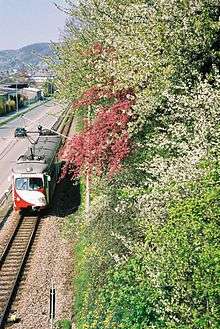
The first section to be electrified was the Käfertal–Viernheim–Weinheim section (which was duplicated at the same time), which was completed in 1915. The electrification of this line also meant that the OEG supplied the town of Weinheim with electricity until 1934. Simultaneously, the tracks of the municipal tramway in Mannheim lying to the north of the Neckar were electrified from the Mannheim station of the OEG (Bahnhof Mannheim OEG or Weinheimer Bahnhof), extending through Paradeplatz, Planken and Wasserturm to the forecourt of Mannheim Central Station. The original design of the contact wire, with the catenary completely warped with cross braces, remained between Käfertal and Viernheim until the integration of the OEG into the VRN.
The First World War delayed the first planned extension of the electrification. It was not until 1928 that the Mannheim–Seckenheim–Neckarhausen–Edingen line was electrified and the line between Mannheim and Seckenheim was duplicated. In Mannheim, a new station at the Kurpfalz bridge called Bahnhof Mannheim-Kurpfalzbrücke or Heidelberger Bahnhof (meaning the station on the line to Heidelberg) connected the tracks to the Mannheim tram network.
Some of the OEG-bound trains now ran on the Paradeplatz–Schloss–Bismarckstraße route to the forecourt of Mannheim Central Station (with a link through Tattersallstrasse to Bismarckstraße), but this link was closed in 1943 after devastating air raids by the Allies.
At the same time a direct, two-track, electrified line was built between Seckenheim and Wieblingen south of Edingen; this was about six kilometres shorter than the single-track line through Neckarhausen (which continued to be operated until 1969). The original Edingen–Wieblingen section was shut down at the same time. Together with the electrification and the new line, Edingen station was relocated to its present location and a new depot was built.
The Käfertal–Heddesheim branch line has been electrically operated since 1946 (it was electrified with material from the disused Feudenheim–Mannheim line).
The last section of the Weinheim–Heidelberg route was electrified between 1949 and 1956 in several sections. Electric trams were able to run around the whole circuit on 1 September 1956.
The OEG lines are electrified with direct current, initially at 1,200 V, but at 750 V since 1974. The vehicles are equipped to operate on the tramways in Mannheim and Heidelberg, which use a voltage of 600 V, although in Heidelberg the polarity is reversed.
After the Second World War / first modernisation
Like most transport companies in Germany, the OEG had a huge increase in ridership after the war to cope with, especially in 1945 when only half of its fleet was available. In 1947 patronage reached a peak of 25.6 million passengers. One of the reasons for the increase was the phenomenon of so-called “foraging trips”, when cheap fares encouraged people to barter for food with farmers. Ridership returned to normal after the currency reform of 1948.
After overcoming the post-war difficulties, the OEG had to deal with incipient mass motorisation. Its goal was to become faster and more convenient in order to hang on to patronage. A first step was the purchase of four open coaches, together with trailer carriages from Waggonfabrik Fuchs.
Also, the network was partly not up to date at it included the non-electrified single-track section along the Mountain Road from Handschuhsheim to Weinheim. It ran at grade along federal highway B 3 and was very accident prone as a result. Therefore, it was moved from 1952 to 1955 on to its own route. An exception to this day is in the built up area of Großsachsen. In 1952, a carriage shed was completed in Schriesheim, which then housed buses in addition to rail vehicles (until 1969).
The modernisation of the fleet was continued with the delivery from 1957 to 1963 of large carriages from Waggonfabrik Rastatt, including the OEG’s first articulated train sets in 1960. At the same time the improvement of the safety of level crossings began with the installation of flashing light systems; this equipment was later augmented with half-barriers.
In 1959, there was the extension of the concession for the railway operations. Due to appeals against its continued operation this was granted on a provisional basis only. Only in 1964 was the license reissued for passenger operations until 2009 and for freight until 1989.
In 1960, the local signal boxes began to be replaced by an automatic block signaling system. The first line to be modernised was from Mannheim to Seckenheim. In 1967, the Schriesheim–Handschuhsheim section was resignalled. In 1969, the whole line from Weinheim to Heidelberg was resignalled. By the end of the 1980s the entire route network had been equipped with automatic block signaling. Today, the lines are controlled by three signal boxes in Edingen, Schriesheim and Käfertal.
In 1966, the eight-axle articulated trams of DÜWAG was introduced to the OEG network, which continue to be the backbone of operations today.

In the 1960s, continuously welded rail began to be installed. The remaining semaphore signals were replaced by colour light signals, which are easier to maintain.
In 1968, as part of the upgrade of the B 38, the line in Viernheim was moved slightly to the southeast. Up to that time the line ran to Kiesstraße curving next to Mannheimer Straße then turned right–approximately following the course of today's road called Auf der Beune–crossed Heddesheimer Straße and then ran just off Ringstraße (now called Berliner Ring) to Viernheim OEG station. It thus run largely on what was then the outskirts. The newly built line, on the other hand, swings away from the Mannheimer Straße after Jahnstraße and runs past the former "beer cellar" and under the new Heddesheimer Straße bridge on an altered route to Viernheim OEG station. The community had negotiated for the line to be moved to this route as early as 1911, along with the construction of the Berliner Ring on the same route.
Viernheim Haltepunkt (“halt”) was moved as a result of this new construction from its previous location between Sandstraße and Kiesstraße to Jahnstraße. In 1972 it was transferred again to the west, however, this time to give access the newly opened Rhein-Neckar-Zentrum shopping mall. In the meantime, it was also renamed Tivoli, as it is adjacent to the Viernheim district of Tivoli. Kapellenberg station, which has since been built further to the northeast on the new route, is now close to the original Viernheim Haltepunkt.
Closures

Because the Seckenheim–Neckarhausen–Edingen line was less used because of the direct line that was built in 1928/29, it was replaced by a bus route in 1969. The kilometre stones on the Neckar river embankment in Neckarhausen are still visible today.
Because of growing competition from road transport for freight, profitability fell significantly in the 1960s, so that the dual gauge freight line between Heidelberg and Schriesheim was closed in 1970 and in 1971 the carriage of freight was abandoned. An exception was the annual sugar beet harvest, which was transported using Rollbocks, which operated until 1983. Otherwise, the OEG operated freight traffic until the early 1990s using road transport.
Further modernisation

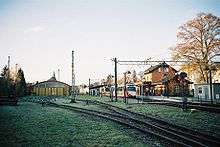
The initially sections terminated in Mannheim at separate OEG stations on either side of the river Neckar near the Kurpfalz bridge. In 1973 the line from Weinheim was extended over the Friedrich-Ebert Bridge over the Neckar to Mannheim Central Station and the Weinheimer station was closed. The grounds of the former station are now used for part of the Neckar promenade, completed in 2006, and at almost the same location a new tram line has been opened along Schafweide.
The depot in Viernheim was closed in the mid-1970s. It was unnecessary, because the main workshop in Kafertal was closed for the establishment of the central transport workshop. Personnel and rolling stock were moved from Viernheim to Käfertal. On its grounds the Deutsche Gesellschaft für Eisenbahngeschichte (German Railway History Company, DGEG) operated a museum of narrow-gauge vehicles from 1976 to 1986. The listed building was in a poor state for a long time and was closed to the public since the removal of the historic OEG carriages. The sidings were removed and the sheds were cleaned up in 2008 and it was converted into an office complex in 2010.[3]
In 1976, professional mobile radio was introduced. By 1977 the railway tracks in the Käfertal OEG station had been completely remodelled since at that time it was in the same condition that it had been when it was built before the First World War and therefore no longer met current requirements. A turning loop was created there. In 1980, Schriesheim station was adapted to the needs of the times and the carriage shed was converted into the central bus depot.
In 1982, the OEG acquired four train sets from the Bielefeld Stadtbahn, which each consisted of a six-axle motor carriage and a four-axle trailer. These one-way vehicles could be used only on the Mannheim Central Station–Käfertal–Heddesheim route because it was the only route with turning loops at its endpoints. This freed up railcars, which were urgently needed for the circular route, where the withdrawal of vehicles that were not suitable for one-man operations had created a bottleneck.
After planning began in 1983, the OEG opened a new route in Heidelberg in 1993: instead of using Bergheimer Straße, it now runs on the tram line along Kurfürstenanlage to Heidelberg Central Station. For this, a new track was built from the direction of Wieblingen, starting shortly before the former OEG freight yard, which was partially demolished at the same time, passing under the and Czerny bridge to the Central Station and connecting with the existing tram route.
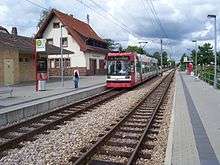
In 1995, the concept of MVG 2000 was implemented that also brought big changes for the OEG. Up to this time, trains coming from Weinheim terminated in the forecourt of the Mannheim Central Station and from Heidelberg in Mannheim Kurpfalz Bridge station (Bahnhof Mannheim Kurpfalzbrücke). The circuit was now closed with trains running through the centre of Mannheim. To achieve this, a short connecting line was built from the front of the Collini-Center, bypassing the Kurpfalz bridge station branch and connecting to the tram line on Friedrichsring. This connection was a restoration; there had been a similar link until 1928 or 1974. The OEG was connected to the Mannheim tram network and now ran with the line designation of 5R (and 5 for trains running only on the Käfertal–Mannheim–Edingen section). Under the MVG concept, the route to Heddesheim became part of the tram network and was operated by Verkehrsbetriebe Ludwigshafen GmbH (VBL, Ludwigshafen Transport, the operator of the Ludwigshafen Tramway). Since then VBL, rather than OEG, has operated tram line 4 from Heddesheim to Ludwigshafen, Oggersheim and Bad Durkheim.
The OEG was thus connected to the two major Deutsche Bahn stations in Mannheim and Heidelberg within a few years.
In 1996, the distribution of the losses of the OEG were revised. Mannheim now contributes 58.2%, Rhein-Neckar-Kreis 30%, Heidelberg 7.2% and Viernheim 4.6% of the losses occurring every year. Until then, the city of Heidelberg had paid nothing at all.
In addition, in 1996, Weinheimer Busunternehmen GmbH (Weinheim Bus Company, WEBU) was established, owned by Stadtwerke Weinheim GmbH (the Weinheim municipal utility, 71.6%) and OEG (28.4%), that has since managed Weinheim city buses. OEG continued to operate bus services for WEBU until 31 December 2009.
In the 1990s, the Heidelberg–Schriesheim section was duplicated to allow better time-keeping. The duplication of the remaining section of the line between Schriesheim and Weinheim was carried out from March 2011 with a seven-month closure of the line with trains replaced by buses.
As a result of the upgrade of the OEG, it was integrated in June 1999 as a full line of the Heidelberg tram network. Have formerly only stopped been between Bismarckplatz and Handschuhsheim Nord at Burgstraße, Handschuhsheim OEG-Bahnhof and Kußmaulstraße, OEG trains has since served all stops (except for the Froschäckerweg stop, but this has now been closed) and replaced in this section tram line 1, which was previously operated by the Heidelberg Tramway (HSB). The Adenauerplatz stop between Bismarckplatz and Poststraße is not, however, served by OEG because of the short distance to the neighbouring stations operated by the OEG.
In 2000, MVV GmbH acquired a share of 94.6% of the OEG from the city of Mannheim and renamed the company MVV OEG AG. 5.18% remains directly owned by the city of Mannheim, 0.2% by the city Heidelberg and 0.02% by the city of Weinheim. Since 2002, the OEG network has been operated together with the Mannheim trams of MVV Verkehr AG.
Transition to the RNV

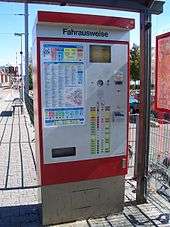
As of 1 October 2004, the MVV OEG AG and MVV Verkehr AG, Straßenbahn Heidelberg, Verkehrsbetriebe Ludwigshafen and Rhein-Haardtbahn jointly own Rhine-Neckar Transport (Rhein-Neckar-Verkehr GmbH, RNV) and operations have been carried out jointly since 1 March 2005. The infrastructure and the concessions remain with the OEG, with the rolling stock going as part of the capital contribution to Rhine-Neckar Transport, which now provides transport services on behalf of the OEG. Since 2005, responsibility for losses incurred will be distributed to the respective districts of Mannheim, Heidelberg, Viernheim and the Rhein-Neckar-Kreis in proportion to net-kilometres operated. The council of the city of Mannheim decided in 2009 to merge MVV OEG AG and MVV Verkehr AG. After acquiring the remaining 0.22% of shares from Heidelberg and Weinheim, Mannheim now holds 100% of the shares. The merger was finalised on 16 March 2010 with the deletion of MVV OEG AG from the share register. As a next step, MVV Verkehr AG became a limited liability company on 31 March 2011.
Since the unification of the area of the RNV, the OEG service has operated as line number 5 since 10 December 2006.
In contrast to the upgrade of signalling carried out after the Second World War, all signalling is being centralised at a traffic control centre at the Mohlstrasse depot in Mannheim, which will cover all the operations of Rhine-Neckar Transport. The signalling is being converted to electronic interlocking technology. Since 10 April 2008, the Weinheim–Schriesheim–Handschuhsheim Nord section is controlled remotely. The Schriesheim dispatcher has since worked out of the RNV control centre at Mohlstrasse. On 10 March 2011, control of the Edingen signal box was also switched to the central control point, so that the signal box is now vacant.
Already the long planned modernisation of the nine kilometre long single-track line between Weinheim and Schriesheim began on 10 March 2010 with a symbolic groundbreaking ceremony. Here, the duplicated track will in future allow operations at 10-minute intervals. A major restructuring of operations was required by the full closure of this section of track. Between 21 March 2011 and 5 November 2011, all trains on the section between Weinheim OEG station and Schriesheim station were replaced by buses, resulting in most cases in a significant extension of travel time. Weinheim OEG station was rebuilt during the summer school holidays. The trains during this period ran through without stopping to the Händelstraße stop, which was equipped for this purpose with a temporary set of points connecting the tracks. Trains have run through again on the now double-track line since 5 November. Only two short sections in the thoroughfares of Großsachsen and Schriesheim remain as single track. In the course of restructuring the entire Weinheim–Heidelberg route was equipped with a new electronic interlocking system. At the timetable change on 11 December 2011, the newly built Großsachsen Süd stop was also opened. The rebuilding of Schriesheim station should be completed by mid 2012.
Ticket-vending machines
In the late 1960s, the OEG acquired the first in a series of 15 ticket machines. Accordingly, in 1969 and 1970, at first some trains, then all trains, operated without conductors. The OEG ordered a further 54 ticket machines, which were set up in 1973 and 1974. Thus the OEG was the one of the first non-federally owned railways with machines at stations as a prerequisite for one-man operations. In 1975, the majority of stations were equipped with ticket machines. Since 1 July 2005, tickets have only available at vending machines or as advance bookings. This is intended to reduce stopping times and to improve train punctuality. To date, however, not all stops have machines. One problem is the possibility of malfunctioning machines.
Renaming of stops
| Formerly | now | when |
|---|---|---|
| Friedrichsbrücke | Kurpfalzbrücke | |
| Viernheim Haltepunkt | Kapellenberg | 1984 |
| Mittermaierstraße | Betriebshof | |
| Vogelstang | Vogelstang West | |
| Käfertal Haltepunkt | Mannheimer Straße | 1995 |
| Donnersberg | Am Ullrichsberg | 1989 |
| Am Ullrichsberg | Im Rott | |
| Gaswerk | Händelstraße | 1998 (?) |
| Tivoli | Tivoli/Rhein-Neckar-Zentrum | |
| Schröderstraße | Brückenstraße | 2002 |
| Wieblingen Süd | Fachhochschule | 2005 |
| Mühlfeld | Berufsakademie | 2006 |
| Berufsakademie | Duale Hochschule | Juni 2009 |
| Neckartor | Abendakademie | June 2009 |
| Handschuhsheim OEG-Bahnhof | Hans-Thoma-Platz | June 2010 |
| Wieblingen OEG-Bahnhof | Wieblingen Mitte | June 2010 |
Operations
Originally, the OEG had four independently-operated passenger lines:
- line A: Mannheim – Weinheim (with carriage shed in Viernheim)
- line B: Mannheim – Heidelberg (with carriage shed in Edingen)
- line C: Heidelberg – Weinheim (with carriage shed in Schriesheim)
- (Unnamed line): Nebenbahn Käfertal – Heddesheim (with carriage shed in Heddesheim)
- (The Rhine-Haardt Railway Mannheim–Bad Dürkheim, treated as line D).
After the completion of the electrification of the Mannheim–Heidelberg–Mannheim–Weinheim triangle of OEG lines in 1956, every second train of the trains bound for Weinheim continued to Heidelberg, creating the so-called "round trip" trains. From 1965 trains running from Mannheim to Heidelberg continued on the circuit, so since that time all trains have operated as round trips except for extra peak-hour trains.
As a result, there was the following line network:
- A Mannheim Hbf – Käfertal – Weinheim – Heidelberg – Seckenheim – Kurpfalzbrücke
- B Kurpfalz bridge – Seckenheim
- C Mannheim Hbf – Käfertal – Heddesheim
In 1995, the trains from Weinheim and Heidelberg continued through central Mannheim. Thus, the OEG trains have operated since then on a circuit, if they do not reverse at Edingen/Schriesheim or Käfertal/Weinheim. At the same time the line via Käfertal to Heddesheim is now operated as part of the extended tram line to Käfertal from Ludwigshafen-Oggersheim, operated by the MVV on behalf of the OEG.
The network from 1995 was as follows:
- 4 (Bad Dürkheim – LU-Oggersheim – Ludwigshafen – Mannheim –) Käfertal – Heddesheim
- 5 Käfertal – Mannheim – Edingen
- 5R Weinheim – Käfertal – Mannheim – Edingen – Heidelberg – Weinheim (round trip)
In 1995, the complete circuit was given the line number of 62 and the short service between Käfertal and Edingen was given the line number of 63 in VRN’s network-wide scheme. Since the MVV in Mannheim, however, used the designation of 5 for the OEG in its Stadtbahn network, after some time the route numbers were changed to 5R (instead of 62) for the entire circuit and 5 (instead of 63) for the short service between Käfertal and Edingen. In the timetable of the VRN the route was listed under the table numbered "R 65". The distinction between 5 and 5R was finally abandoned in late 2006 and since then only the number 5 has been used, which is now used for the table number in the timetable.
The course of the OEG circuit in the city of Mannheim resembles the figure"8" with the line intersecting on the south bank of the Neckar River (at the Friedrich-Ebert Bridge), but there are no stops allowing a change of trains at this barely perceptible intersection.
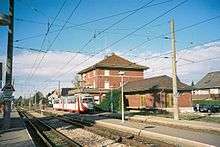
This complete circuit is particularly demanding in terms of reliability and punctuality, neither delayed nor early services are welcome. The OEG does not yet have any passing tracks in Mannheim or in Heidelberg, where it has no allowances for recovery time in its timetable, as this would disturb tram traffic. This means that the OEG rail operations at times have significant and repeated irregularities: a delay of ten minutes or more frequently occur at certain times of the day. Scheduled connections are often not achieved. The OEG therefore now has more allowances for recovery time in its timetables at Schriesheim, Edingen and Käfertal, but the standing time of the trains, especially if these stations are halfway on passenger’s journeys is disturbing.
The OEG operates with bidirectional vehicles at both ends of the sets and need no turning loops. The OEG is the only line in Mannheim with this characteristic, while at the tramway at Heidelberg has been a consistently bi-directional operation since 1974.
Notes
- ↑ Eisenbahnatlas Deutschland (German railway atlas). Schweers + Wall. 2009. ISBN 978-3-89494-139-0.
- ↑ Gerald D. Feldman (1998). Hugo Stinnes: Biographie eines Industriellen, 1870–1924 (in German). Munich: C. H. Beck. pp. 268 ff. ISBN 3-406435823.
- ↑ "OEG-Wagenhalle" (in German). Ingenieurgemeinschaft Kronach und Müller. Retrieved 23 July 2012.
References
- Dieter Höltge (1972). "Oberrheinische Eisenbahn-Gesellschaft". Kleinbahnhefte (in German) (Gifhorn: Verlag Zeunert) (6).
- Axel Juedtz (1976). Die Entwicklung des öffentlichen Nahverkehrs der Stadt Mannheim (in German). Heidelberg.
- Werner Rabe (1979). Betriebsgeschichte MVG, VBL, RHB (in German). Mannheim.
- Bernhard König und Werner Rabe (1982). Fahrzeugstatistik des Bahnbetriebes der Oberrheinischen Eisenbahn-Gesellschaft AG (OEG) (in German). Mannheim.
- 75 Jahre OEG – 1911–1986 (in German). Oberrheinische Eisenbahn-Gesellschaft AG. 1986.
- Bernhard König (1990). "Die Oberrheinische Eisenbahn-Gesellschaft AG – 100 Jahre meterspurige Eisenbahn in Heidelberg". BDEF year book (in German). pp. 137–172. ISBN 3-922657-82-6.
- Gerd Wolff and Hans-Dieter Menges (1992). Deutsche Klein- und Privatbahnen (in German) 2. Freiburg: EK-Verlag. pp. 104–149. ISBN 3-88255-653-6.
| Wikimedia Commons has media related to OEG. |